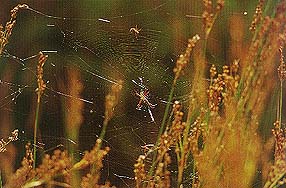Text and pictures by Nell O'Briant Bednarz
 Last November a group of science students from the Abu Dhabi Indian School discovered a dense colony of several dozen orb-weaving garden spiders. I was guiding them through Bateen Wood, roughly 35 hectares of semi-wild plantation on Abu Dhabi Island. The discovery created a good deal of excitement, because few of us had seen more than an occasional spider in the past. In fact, I habitually visit the wood for birdwatching, but I had never seen spiders there, being intent on other subjects.
Last November a group of science students from the Abu Dhabi Indian School discovered a dense colony of several dozen orb-weaving garden spiders. I was guiding them through Bateen Wood, roughly 35 hectares of semi-wild plantation on Abu Dhabi Island. The discovery created a good deal of excitement, because few of us had seen more than an occasional spider in the past. In fact, I habitually visit the wood for birdwatching, but I had never seen spiders there, being intent on other subjects.
The orb weavers are perhaps the best known of all 32,000 + species of spider. These creatures fascinated human beings since ancient times, and many people fear them. Close observation would lead one to the wise conclusion that the garden spider need only be feared by small insects.
The female spider begins as a faintly marked immature, but she develops into a beauty after several moultings. At maturity, the legs are banded with alternately dark and light lines the width of a blunt pencil lead, with an underlying reddish colour during breeding. Her abdomen is likewise banded, with the light bands tinged with pale yellow; the cephalothorax is a pale yellowish brown, with four beady, black eyes attached. The underside of the spider, where the silk-producing spinnerets are located, is brightly marked with a red patch and two yellow stripes.
Mature females measure about 1 inch (25 mm), from pedipalps to tip of abdomen, and hang head downward in a tightly woven web, which usually has vertical, zig-zag markings called stabilimenta. Looking closely, one sees the much smaller, brown male - about 1/2 inch (12mm) long at maturity. Mature males are found within the web of the female or within barrier webbing, a warning and stabilizing structure found among webs of mature females.
By mid-December, the spider colony has produced offspring, brown spiderlings the size of mustard seed suspended within a nest of golden silk. Hundreds of spiderlings take to the air, ballooning to a new home on a fine silk strand. Earlier generations probably flew into this wood as youngsters, possibly from Iran or Jordan during a strong, spring storm.
Life is dangerous for such tiny weavers, Besides the possibility of becoming prey to one another, they are also eaten by dragonflies, lizards, and birds, as well as toads in other locations. Warblers feed on them and also use the spiders' silk to line their nests in spring. In the fine winter weather, the spiderlings prosper, but heat is a severe limitation in the summer months.
The tall grasses and densely shaded areas under bushes and trees provide the essential habitat requirements of moist mulch and shade, as well as harbouring nourishing insects. Mowing in Bateen Wood would drastically reduce the spider population. Therefore, this must be done in a planned manner, leaving grassy patches for the survival of this and other species of arachnid.
Over the winter months, this garden spider lives prima-rily on the clumps of rushes within the wetter areas of the wood. Such creatures as mosquitos, ants, and leafhoppers are caught and eaten by the spiderlings. Besides grasshoppers and cockroaches, the Balkan pierrot (Taurus balkanicum), Lederer's cupid (Chilades galba) and related butterflies are important nourishment for mature spiders.
The typical orb weaver eats about twice its own body weight in insects every day (not to mention those caught but not eaten), approximately 2000 insects within the single year of its life cycle. Multiplying this by the hundreds or thousands of spiders found in a well managed woodland, it becomes clear that Argiope helps provide a balanced ecosystem. In fact, farmers around the world are increasingly turning to these creatures as beneficial predators, because they primarily eat destructive pests rather than beneficials, as reported by Jill Jesiolowski and Dr. Susan Riechert in Organic Gardening , (July/August 1995 issue).
In early May, when the fall hatchlings were half-grown, I stumbled across a few mature females, one with glowing red legs. She was encircled by six, mature males! This is considered an indication that the female is typically non-aggressive to the male when mating. The fact that most males (those little socialites!) abandoned spinning silk in favour of sitting at the edge of a female's web seems to support that idea.
Obviously, the May date for these few spiders was the end of their life cycle. Therefore, the spiders have been in Arabia long enough to have overlapping generations, rather than one per year. The warm climate is undoubtedly the reason for this, a real boon for anyone interested in studying spiders.
As the temperatures increase during the summer months, the rushes are abandoned in favour of shadier places. Hopefully, as the temperatures drop in autumn, the beautiful banded females and their smaller male consorts shall return to a prominent perch for all of us to study and enjoy.
Author's Note: Thanks to H. E. Mohammed Fadhil al Hameli, Assistant Undersecretary of the Abu Dhabi Municipality, Bateen Wood has been designated as a protected wildlife area and outdoor classroom, overseen by the National Avian Research Centre (NARC). Little is known about the hundreds of various arachnids found in Arabia. currently, arachnid specialists Norm Platnick and Lou Snorkin of the American Museum of Natural History in New York, as well as Barbara Tigar, entomologist for NARC, are studying this species and hundreds of others from the United Arab Emirates.
Web Links | Subjects | Search
Arabian Wildlife. Volume 2, Number 3